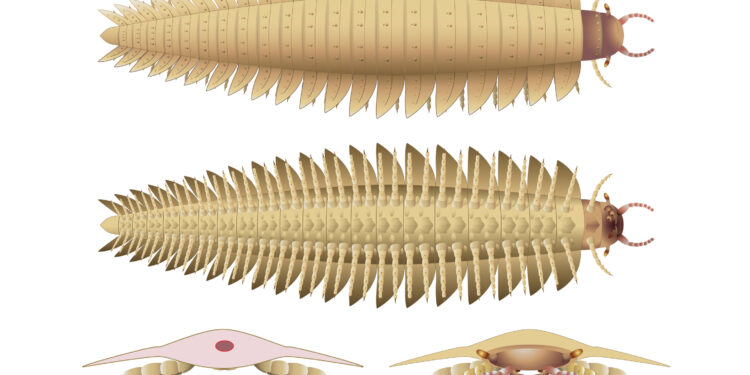This illustration provided by researchers in October 2024 depicts a juvenile Arthropleura insect reconstructed from fossils discovered in Montceau-les-Mines, France. Credits: Mickaël Lheureux, Jean Vannier, Alexandra Giupponi via AP
As if the largest insect ever alive – a nearly 9-foot-long monster with up to 64 legs – wasn’t terrifying enough, scientists could only imagine what the extinct beast’s head looked like.
Indeed, many of the fossils of these creatures are headless shells that were left behind when they molted, wriggling out of their exoskeletons through the head opening as they grew – up to 8 at 9 feet (2.6 meters) and over 100 pounds. (50 kilograms).
Now, scientists have made a photo after studying complete and very well preserved, if not downright cute, juvenile fossils.
The top of the giant insect was a round bulb with two short, bell-shaped antennae, two protruding eyes like a crab, and a rather small mouth adapted for crushing leaves and bark, according to a new study published Wednesday in Scientific advances.
Called Arthropleura, these were arthropods (the group that includes crabs, spiders, and insects) with characteristics of modern centipedes and centipedes. But some of them were much bigger, and this one was a surprising mix.
“We discovered that it had the body of a centipede, but the head of a centipede,” said Mickael Lheritier, co-author of the study and paleobiologist at Claude Bernard Lyon University in Villeurbanne, In France.
The largest arthropleids may be the largest insects to have ever existed, although there is still some debate. They could be right behind an extinct giant sea scorpion.
Researchers in Europe and North America have been collecting fragments and footprints of these enormous insects since the late 1800s.
“We’ve wanted to see what this animal’s head looked like for a very long time,” said James Lamsdell, a paleobiologist at West Virginia University who was not involved in the study.
To produce a model of the head, the researchers first used CT scanning to study fully intact juvenile fossil specimens embedded in rocks found in a French coal deposit in the 1980s.
This technique allowed researchers to examine “hidden details like pieces of the head still embedded in the rock” without altering the fossil, Lamsdell said.
“When you erode a rock, you don’t know what part of a delicate fossil may have been lost or damaged,” he said.
The juvenile fossil specimens were only about 6 centimeters long, and it is possible that they were a type of arthropleura that did not grow to enormous sizes. But even if that’s the case, the researchers said they’re close enough to provide a glimpse of what the adults — whether giant or less nightmarishly sized — looked like when they were alive there. 300 million years ago.
More information:
Mickaël Lheritier et al, Anatomy of the head and phylogenomics show that the giant Arthropleura of the Carboniferous belonged to a group of centipedes, Scientific advances (2024). DOI: 10.1126/sciadv.adp6362
© 2024 The Associated Press. All rights reserved. This material may not be published, broadcast, rewritten or redistributed without permission.
Quote: Scientists now know what the head of the largest insect that ever crawled on Earth looked like (October 9, 2024) retrieved October 9, 2024 from
This document is subject to copyright. Except for fair use for private study or research purposes, no part may be reproduced without written permission. The content is provided for informational purposes only.



